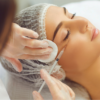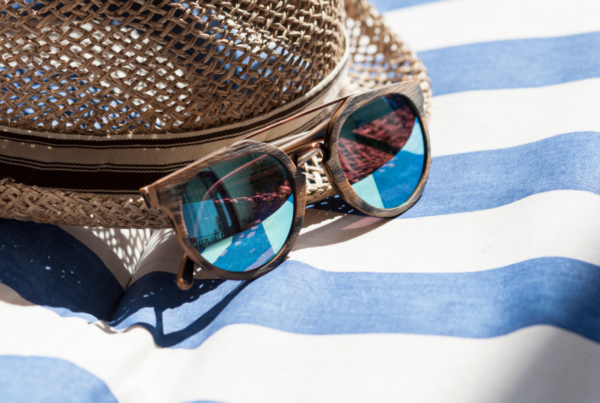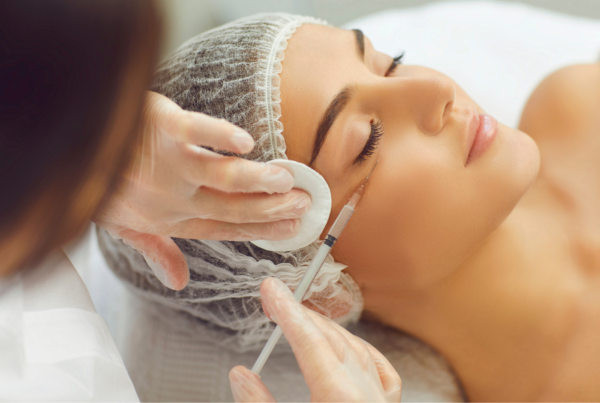If your eyes feel gritty, sore, itchy or tired, speak to your Optician about the possible causes of these symptoms and the probability of Dry Eyes. Your Optician is the best practitioner to diagnose and manage your eye health concerns. Continue reading to see how modern times bring modern solutions to this age-old ailment.
Dry Eye – Management Solutions
In Part 1, we explored the signs, symptoms and causes of dry eye. Let us now look into the most current management techniques for this syndrome.
To best manage a dry-eye disease, we have to manage the patient expectations first. Dry eye syndrome is a chronic condition. This means that the condition can come back if techniques to control it are not adhered to.
During the sight-test or dry-eye assessment, the examiner would have conducted a thorough evaluation to explore the reasons behind the patient’s symptoms. Through questioning and examining, a fair report can be generated to localise the causes.
“Treat the cause, not the symptoms”

Image (1) Oodo Optical
Lifestyle changes
- Stop smoking: Smoking causes numerous documented long-term diseases, including heart and lung damage. However, other problems include cancer, premature ageing, diabetes, cataracts, macular degeneration (affecting the most vital zone of the retina), uveitis (painful inflammation of the uvea), glaucoma, vision loss and dry eye disease1. Since smoking is detrimental to the quality of life, for the patient and family members that become passive smokers, dry eye is a small ailment to cure, compared to the other life and sight-threatening diseases caused by smoking.
- Drink more water: Dehydration of the body will give rise to dehydration of the eyes too. When the body is lacking water, it will prioritise water to vital organs first, such as the brain2. Therefore, making it a habit to drink more water daily will rehydrate the entire body and consequently the eyes.

Image (2) Credit: Shutterstock
- Reduce alcohol intake: Alcohol is a diuretic, ridding the body of fluid and causing dehydration. Even small amounts of alcohol can increase dry eye3.
- Humidifiers: Air conditioning and heating both remove humidity from the air, making the environment dry. Dry air will trigger dry eyes as well as having adverse effects on breathing and exasperating skin conditions. A humidifier adds moisture back into the air by emitting water vapour in the form of a mild mist or steam. A simple alternative to buying a humidifier would be to place bowls of water in discreet places around a home or office. By means of evaporation, moisture is added to the room. Ensure that the water is topped up regularly.
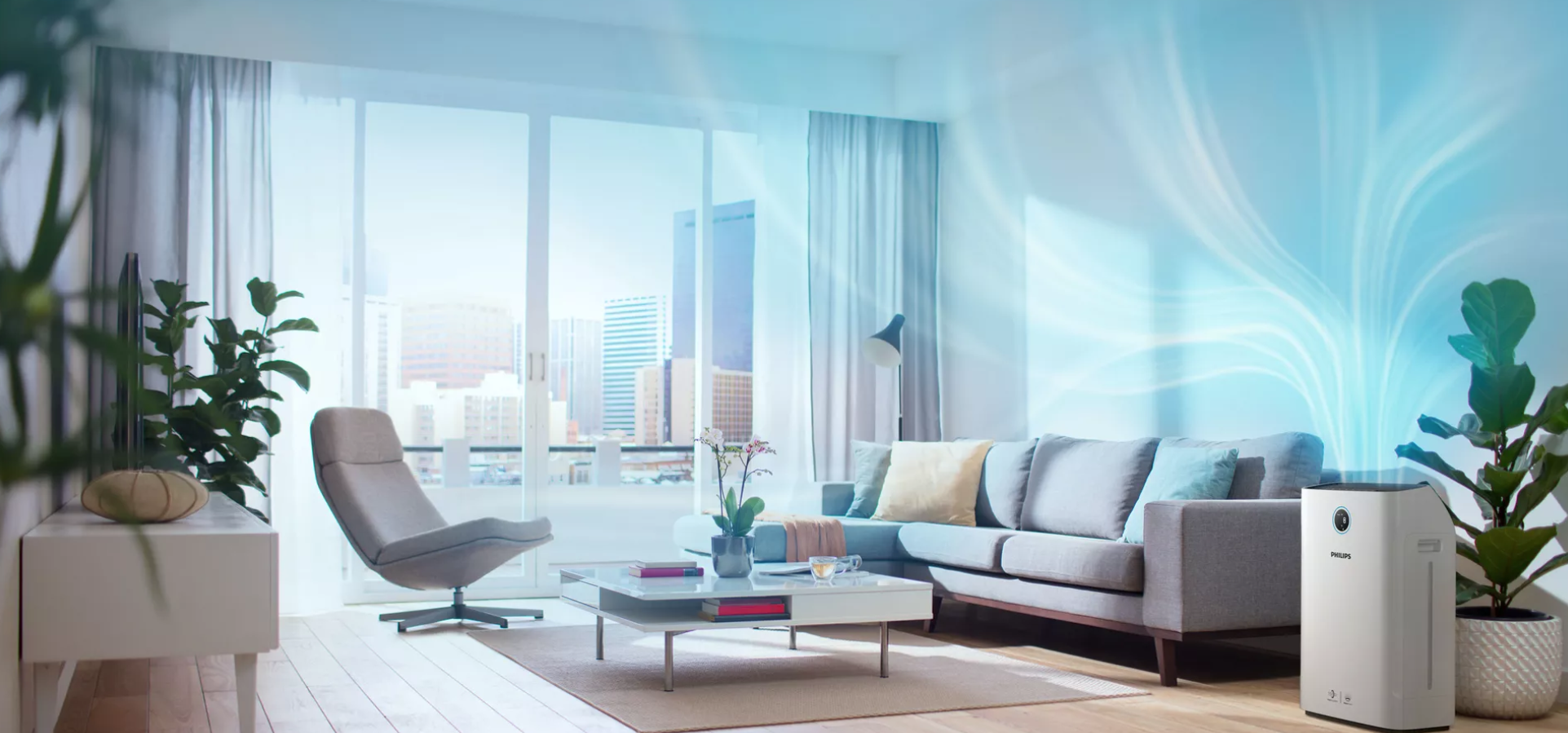
Image (3): Courtesy of T3.com – Best humidifier 2020
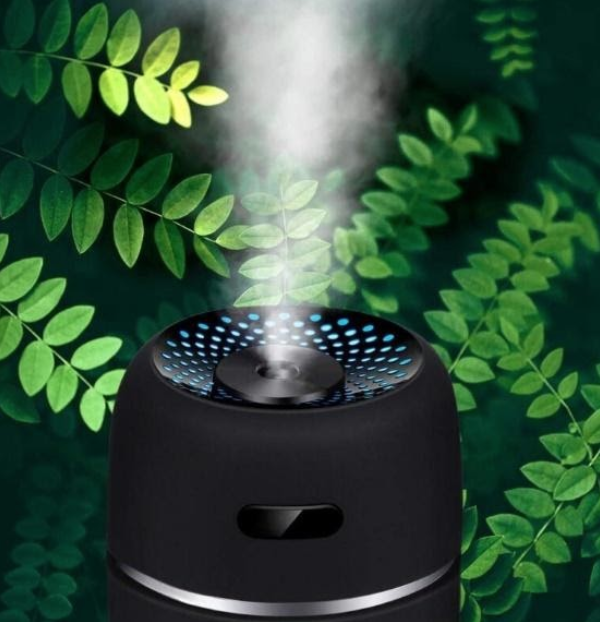
Image (4) Car humidifier – courtesy of Google sites
- Driving: Drivers would benefit from keeping the car fans on a low setting, and most certainly, directed away from the face to minimise tear evaporation. Where heated car-seats are available, use this feature to reduce the need for fan heaters. Car humidifiers can be clipped to the air vents to release low levels of moisture to the cabin of the vehicle.
- Take supplements: Omega-3 fatty acids are a group of essential oils associated with many health benefits including heart and brain function as well as fighting inflammation4. For the eye’s specifically, Omega-3 oils contribute to the improvement of the oily, lipid layer of the tears5. This increases the comfort level of the eye with each blink. Dry skin, dry eyes and night blindness* are symptoms of vitamin A deficiency. The lack of vitamin A causes the cornea to become very dry6. The most effective way of administering vitamin A to the eye is via the use of eye drops or ointments. Excessive vitamin A supplements can lead to toxicity7. Therefore, topical drops would be advisable.
Image (5) Credit: Shutterstock
- Wear sunglasses: Sun and wind exposure can cause dry eyes, therefore it is highly recommended to wear sunglasses or wrap-around eyewear to protect the eyes from exposure to the natural elements. Even walking on a cold day can lead to the rapid evaporation of tears.
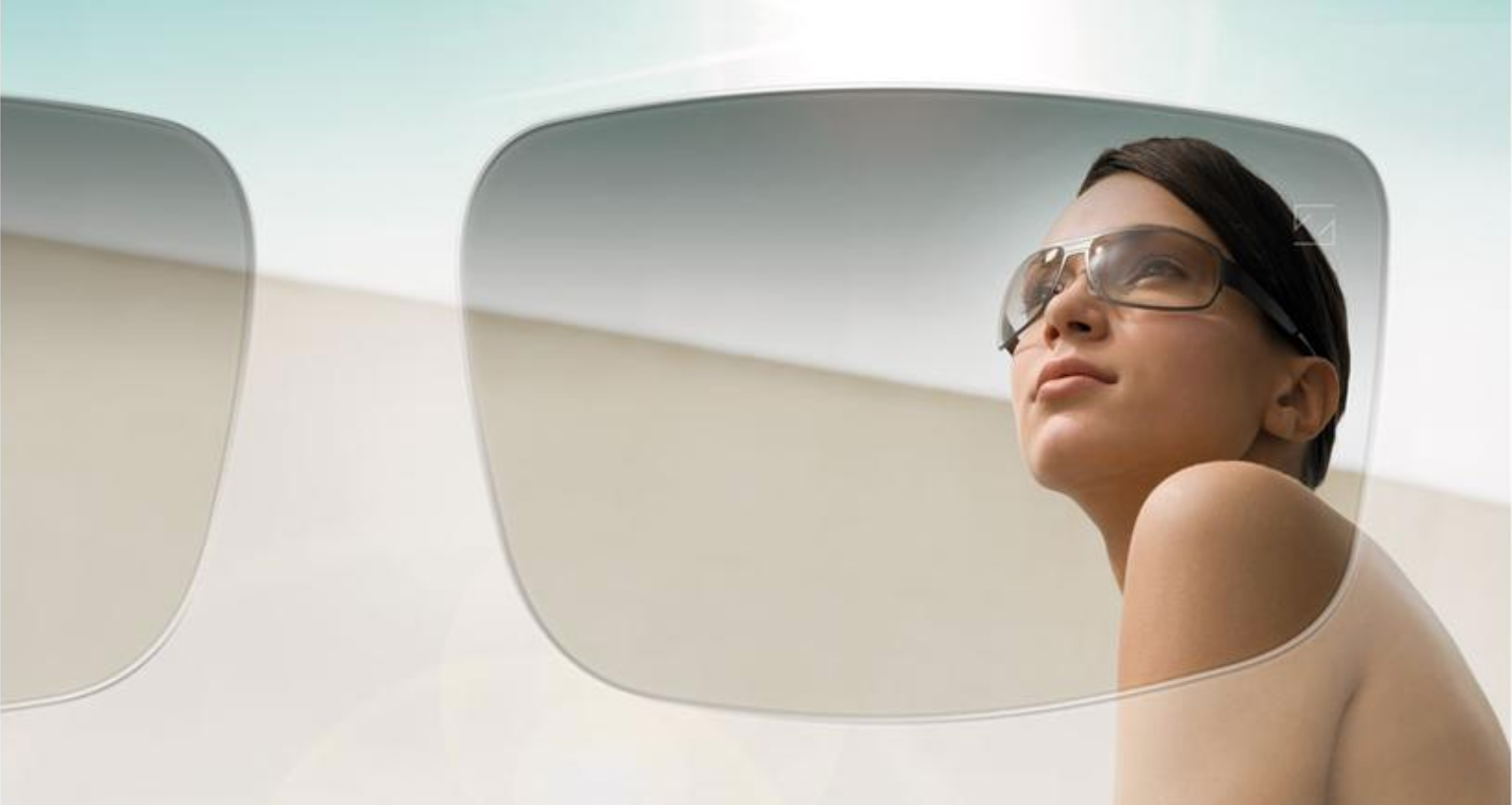
Image (6) Credit: mivision.com.au
- Other outdoor eye protection: Swimming goggles are recommended for sea-water swimming as well as for chlorinated pools. Seawater, lakes and streams have varying degrees of pollution that can cause eye infections. Chlorinated swimming pools can cause toxic stress on the eye due to the high levels of chemicals added to the water to keep it clean. Swimming goggles will prevent exposure to either type of water and consequently, prevent the degradation of the tear-film.
Image (7) Credit: Shutterstock
- Work: If using the VDU or doing a job that requires a high level of concentration, take regular breaks from the task and be mindful to blink more. This minimises tear-film evaporation. If working in an environment where there is dust or debris, wear safety specs to avoid irritation to the eye. Foreign bodies in the eye can lead to ocular abrasions and reflex watery eyes. Working outdoors exposes one to natural elements. Hence, wear sunglasses for UV protection and wind-guard.
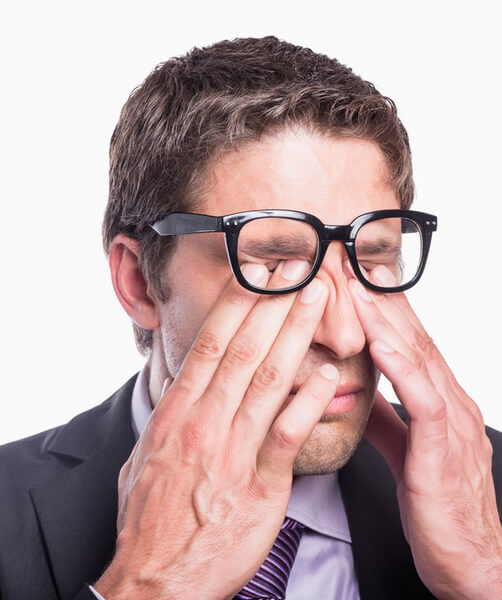
Image (8) Credit: Shutterstock
- Blinking exercises: Spending time to do ‘blinking exercises’ will improve the tear circulation, provide regular ‘re-wetting’ of CLs and reduce intermittent blurry vision. Exercises for dry eye include, fully closing the eyes for a few seconds, re-open and then fully close again several times. Another exercise is to squeeze the eyes closed, engaging all your eye and cheek muscles, and keeping the eyes closed for 5 seconds, to re-open slowly. Repeat this several times8.

Image (9): Courtesy of youreyesite.com
- Meditation: Stress leads to anxiety, depression, hormone changes and poor sleep, all of which contribute to dry eyes. Take time out every day to unwind, clear the mind of thoughts, and rest. Everyone’s meditation will vary in technique and timing, but for the novice, it would be suggested 10 minutes alone-time, in a quiet place. Sit or lie down comfortably, close your eyes and focus on your breathing.
Stress causes shallow and erratic breathing which consequently affects the blood flow and oxygen supply. For anyone new to meditation, it is a method to bring calmness into your being. So, closing the eyes and learning to breathe fully, engaging the lungs to full capacity, is a good start. Meditation can steadily grow to include music, reading, walking, yoga or whatever one finds de-stressing. By mastering the breathing and the heart-rate, it is amazing how many ailments can be controlled.

Image (10) Shutterstock
Dry Eye Treatment
- Contact lens management: Change from annual or monthly lenses to daily disposable lenses wherever possible (to reduce deposits associated with continuous-wear CLs), refit contact lenses to a different parameter (experiment with new base-curves and diameters). Change the CL material (increase ‘wettability’). Reduce wearing time of contact lenses wherever possible.
Image (11) credit: Shutterstock
- Eye-drops: Artificial tears add instant moisture to the eye. Some eyedrops evaporate from the eye very quickly so purchase drops that include an element of lubrication. The slightly oilier drops will evaporate less and provide a more continuous layer of moisturisation. Apply preservative-free eye drops to avoid an allergic reaction to the preservative content. These drops are generally more expensive but the benefit outweighs the cost. Drivers can apply these comfort drops before a journey to stabilise the tear film and create a smoother optical surface to enhance vision.
For severe dry eye, a night-time ointment would be recommended. This ointment is much oilier in its content, making the vision blurry. Hence, it is best applied just before bedtime. Solution treatments are available in forms of drops, ointments, gels and sprays. The latter is particularly effective during hay fever seasons by spraying a gentle, cool mist over the eyelid margins.
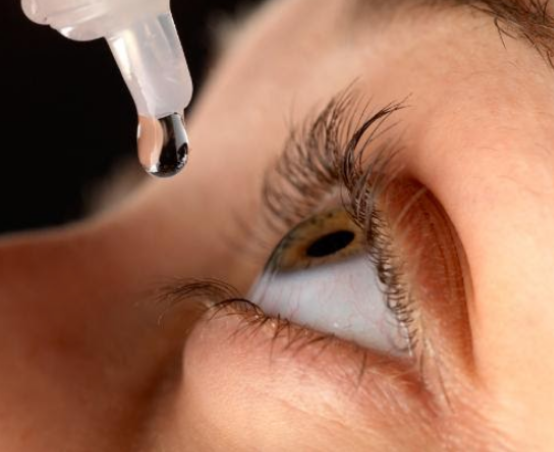
Image (12) Courtesy of Better Vision Guide
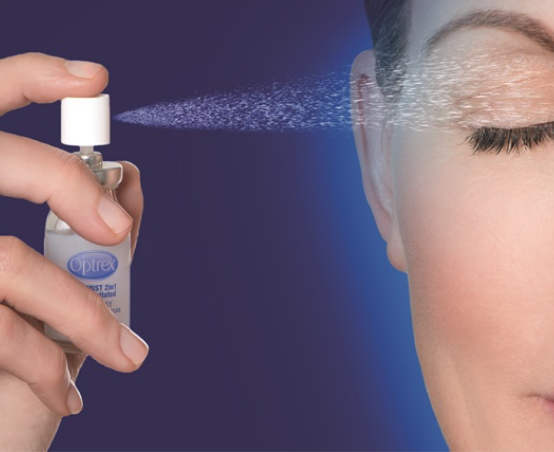
Image (13) Courtesy of Pharmaceutical-Journal.com
- Eyelid hygiene: Invest in commercially available ‘eyelid-cleansers’ to clear lash debris or Blepharitis (see image 14). When the condition has been detected, use the lid wipes day and night. When the lashes are clean, continue using the eyelid cleaning solutions to avoid re-occurrence of blepharitis. Eye make-up should also be thoroughly removed from the lid margins to avoid blocking the vital glands required for tear production. Throw away old eye make-up that may cause recurring eye infections.
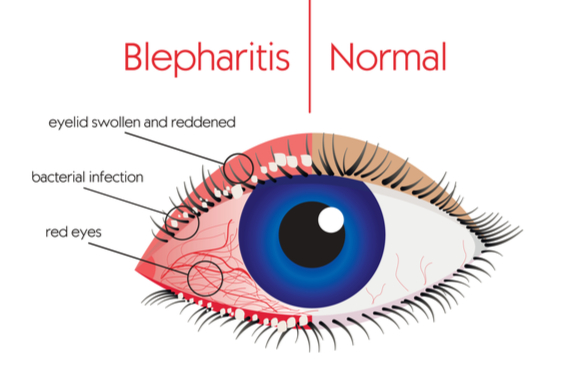
Image (14) Credit: Blepharitis Symptoms
- Warm/Cool eyelid masks: Apply hot compresses to warm the glands associated with tear production. By warming the lashes and lids, it becomes easier to clean any lash debris and it encourages the lid-glands to expel the desired lipids to the tears. With regular hot compresses and lid massages, any blocked glands will open up. Conversely, ‘cooling masks’ can be used during bouts of allergy exposure (hay fever) to relax inflamed eye-lids.
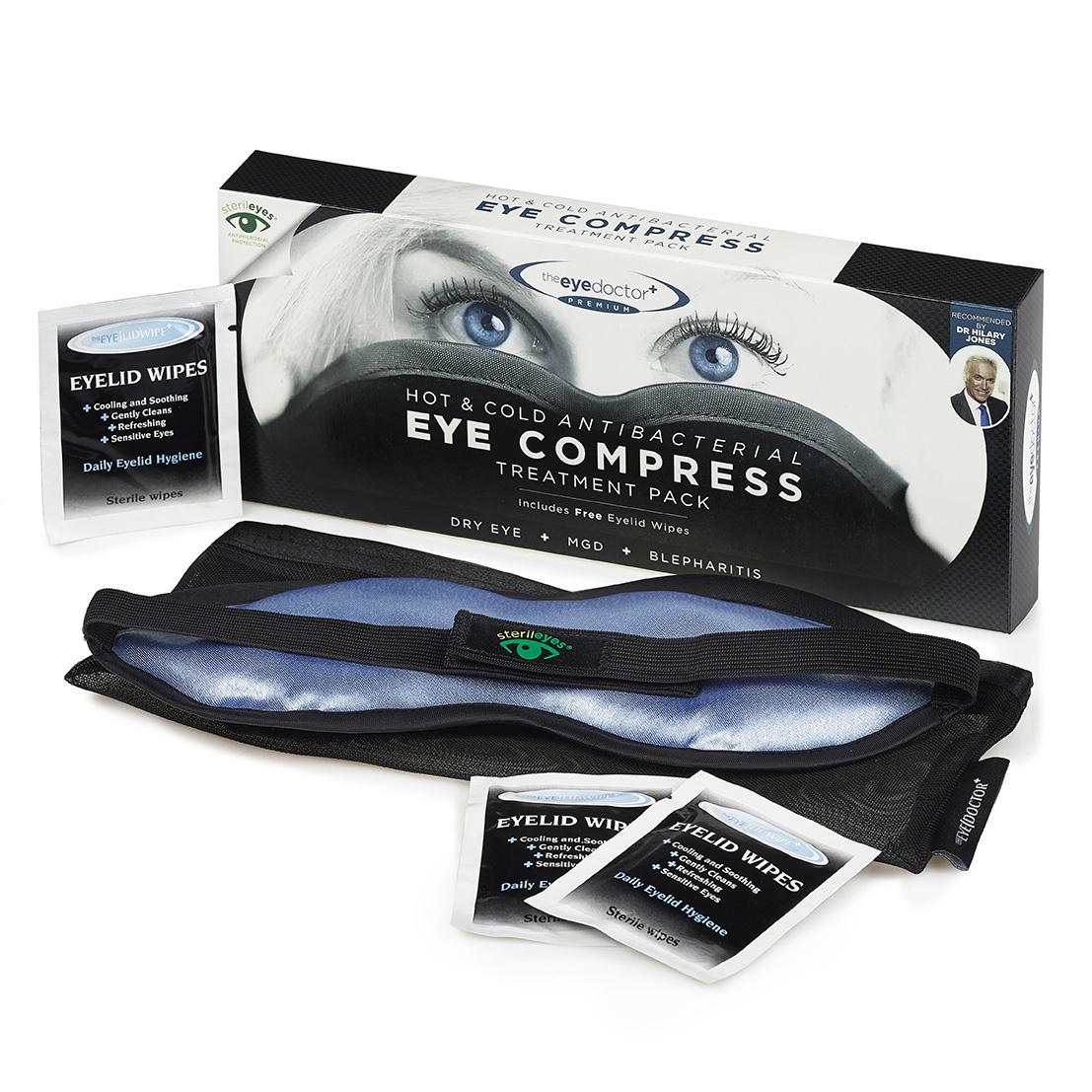
Image (15) courtesy of The Eye Doctor
Advanced Dry-Eye treatment
- Punctal plugs: Punctal plugs (also known as punctum plugs) are a solution to prevent excessive loss of tears for patients that have severe dry eye. The small implants are inserted into the tear ducts that normally drain the tears9. By blocking the tear outflow, a reservoir of moisture is retained within the eye and prevents dry eye. Once inserted, the plugs are not painful and most patients cannot feel them10.

Image (16) Courtesy of Positive Impact
- Eyelid surgery: Where the eyelid is turning in, known as Entropion, surgery is carried out to turn the eyelid to its normal position, as best as possible, by tightening the lid area. The treatment is managed under a local anaesthetic, and often by day release surgery11. The aim is to reduce corneal abrasions and its associated symptoms including reflex tearing.
Ectropion, in contrast, is when the eyelid margin sags outwards, exposing the lower eye area. The outward turning eyelid not only causes dry eye via exposure, but it cannot retain the reservoir of tears in the lid margins. Impartial lid closure is another problem created by Ectropion. The surgery for Ectropion is under a local anaesthetic, in a day release clinic12. A minor operation is required to turn the eyelid back to its desired position. The surgery may entail removing a small part of the loose skin or grafting, depending on the nature of the Ectropion13.
Recommended products by the author
Being in optics for nearly 3 decades, I have seen how the industry has evolved in the past few years alone. Gone are the age-old, primitive recommendations of using ‘dilute baby shampoo’ to clean the eyelids. Now we have an explosion of wondrous products that clean, manage and sustain healthy eyes.
When dry-eye products had not been introduced to the market, ‘dilute baby shampoo’ was the recommended technique to clean the lids and lashes. However, if even a trace amount of baby shampoo went into the eye, the eyes would react to the chemicals, becoming red, with a burning sensation and cause reflex lacrimation. Post cleansing, the skin around the eyelids would become extremely dry again causing another bout of inflamed, crusty lid margins. This old-fashioned method must be discontinued and superseded by advanced lid-cleaning products.
There shouldn’t be any doctor or optician out there recommending ‘baby shampoo’ to clean the lids when there are ophthalmologically tested and verified products that protect and enhance the tear-film mechanism.
Thea Pharmaceuticals
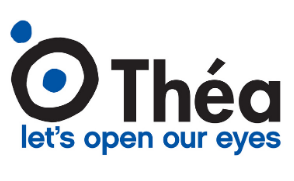
Product logo courtesy of Thea pharmaceuticals
Opticians are regularly upskilling their levels of product knowledge, just like any other medical profession or career. As we master the root causes of ailments, pharmaceutical companies are able to create products that are engineered to provide the best biochemical eye health protection.
Let us explore one of my favourite product-ranges
Thea are a family-owned company whose sole focus is ‘eye health’. In its 150th year, Thea are a pioneering company bringing eye health to the forefront. Their commercial products are all preservative free, thus avoiding toxic reactions**. Thea’s management moto is simple and effective. To treat dry eye and associated eye lid disorders, apply the following care regime:
Heat & Massage, Treat, Manage
Heat treatments: Heat bags, strategically designed in the form of eye masks, provide a desired flow of temperature to the eye area (see image 15). After heating the bag, the patient should lie down with the warm bag over their eyes, for 10 minutes, and let the steady flow of heat open up the eyelid glands, and loosen-up any debris on the lashes. When using the eye masks for the first time, a recommended regime would be to use the bag ‘day and night’ for 2 weeks. This can be reduced to daily use or as required, thereafter14. The eye bag will begin to cool down after 10-15 minutes.
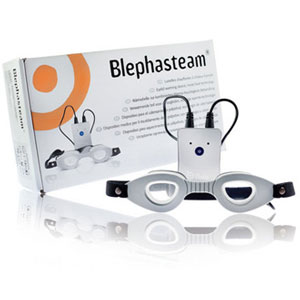
Image (17) Courtesy of Dry Eye Treatments
Similarly, Blephasteam, the electronic medical device by Thea Pharmaceuticals, delivers controlled measures of moisture and heat to the eyelids (see image 17). The CE regulated appliance is easy to use. The recommended 10-minute heat treatment works under the same constant and stable flow of temperature. The patient benefits from clear vision during the treatment, which means that they can read a book or check their emails whilst the device is in use.
After any heat treatment, it is recommended that the patient gently massage and clean the eyelids.
The Blepha Cleansing Range
The skin around the eyes is the thinnest skin on the body hence only gentle cleansing products should be used in and around these zones.
Tested by dermatologists, the Blepha range is free from soap, preservatives, parabens and perfumes. Used as a daily eye care regime, these products remove dust, pollen, make-up, lash crusting and discharge from the eyelid areas. Each Blepha product varies in its unique formulation and is available to purchase in forms of lotion, gel or sterile wipes.
Poor eyelid health and hygiene can result in cataract operations being cancelled due to risk of contamination. Therefore, eyelid management should begin at least 3 weeks before surgery. Post-surgery aftercare should also be advocated.
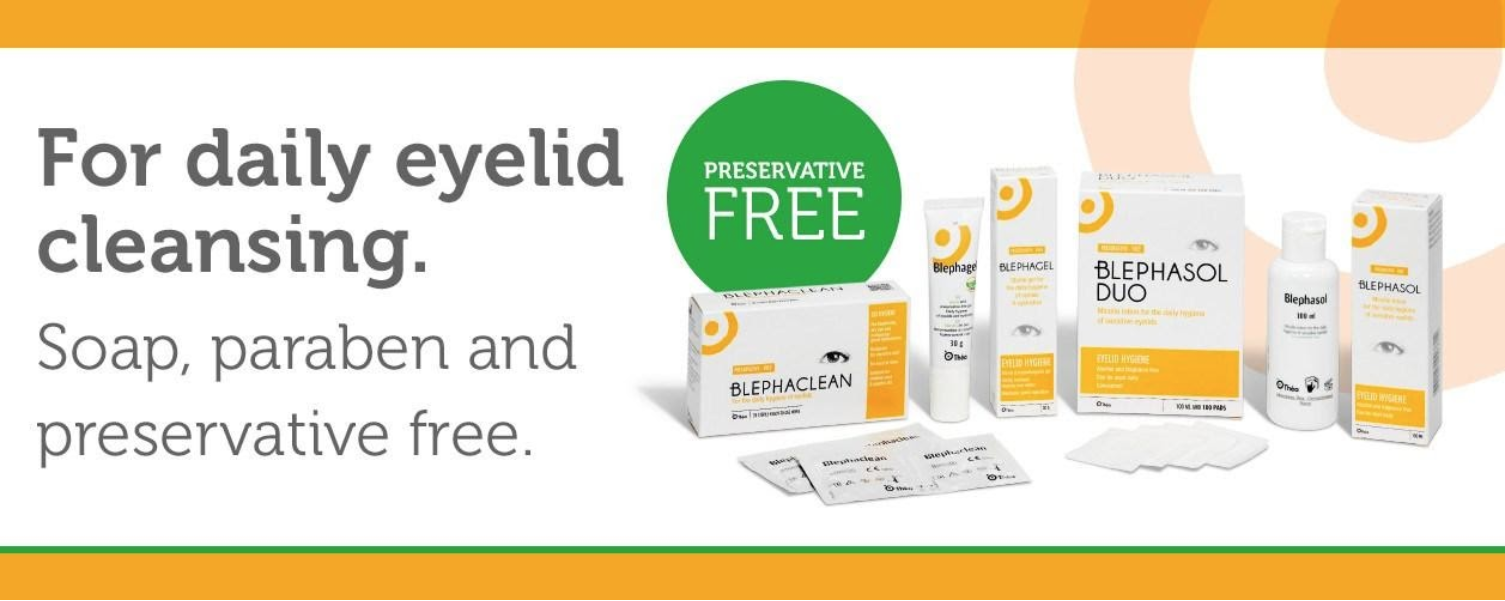
Image (18) The Blepha Range
Blephaclean: Blephaclean is a CE marked medical device, clinically proven to clear blepharitis and treat meibomian gland dysfunction. The box contains ready-to-use sterile wipes which make them convenient to use and easy to travel with.
This product is a ‘Micellar’ cleansing system which draws out impurities from the delicate eye area without having to use foam or scrub action. Whilst micellar technology has grown in popularity over the most current generation, Thea have been applying this science for many years.
Blephaclean is produced with extra active ingredients to target Blepharitis at its initial diagnosis. The mode of treatment is recommended as cleaning the eyes twice, daily for 3 weeks. This can be considered the initial treatment phase, followed by a management routine. Using Blephaclean once daily thereafter would be sufficient to maintain the healthy lid and lash margins.
The sterile wipes are suitable for contact lens wearers and for children over 3 months old.
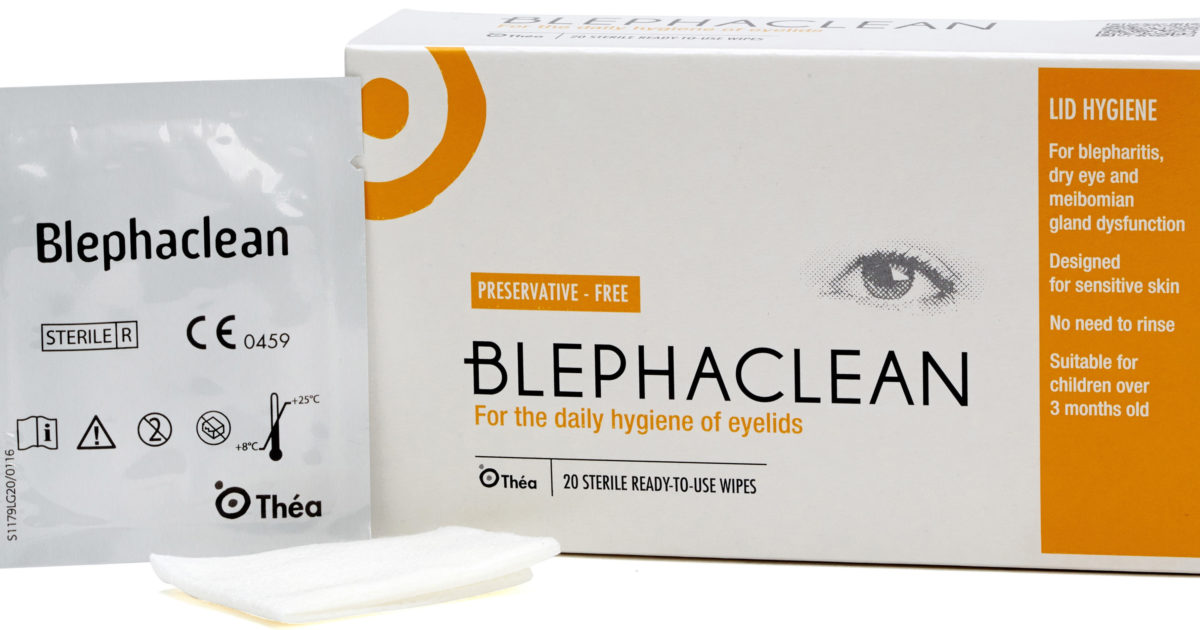
Image (19) Courtesy of Thea Pharmaceuticals
Blephasol: The 100ml bottle of the solution also works with micellar action, drawing out impurities from the lid and lash zones. It is a cosmetic product with plant extracts making it moisturising, anti-ageing and oil-regulating. It doubles up as an excellent eye make-up remover which means one bottle can cleanse and maintain lid hygiene in a single solution.
Blephasol is suitable for contact lens wearers. It can be used for anyone aged 12 years and over. As a daily cleanser, the solution bottle is more cost-effective than the wipes, allowing up to 2 months of usage per bottle.
The lotion can be purchased with and without wipes. It would be advisable to purchase Blephasol in its duo pack to include the specially created lint-free pads which are ‘fluff-free’. Regular cotton wool-balls are very absorbent resulting in an excess of the solution to be used and can leave fluff on the lashes.
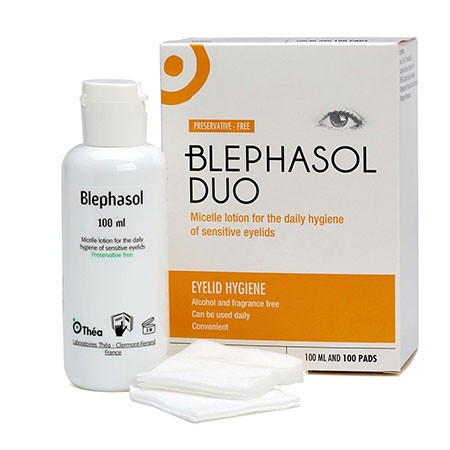
Image (20) Courtesy of The Pharmaceutical Shop
Blephagel: This cleansing gel is ideal for patients exhibiting extreme cases of eyelid problems. Its simple aqueous formula is suitable for the most sensitive customers, produced with the least amount of ingredients. It is the ideal formulation for inflamed eyelids since the gel creates a cooling sensation to soothe and hydrate the lid margins.
The Blephagel tube remains sterile after opening due to its aluminium, airtight properties. A measured dose is dispensed at each pump to avoid waste of product.
The gel is suitable for daily use at any time of the day. When applied in the evenings, the lids are being soothed, softened and cleansed throughout the night. The lids can then, be cleaned in the morning using a cotton pad.
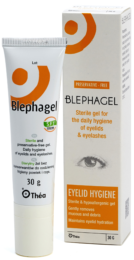
Image (21) Courtesy of Thea Pharmaceuticals
Blephademodex: Launched in January 2019, Blephademodex is the newest member of the Blepha product range. It is a medical device to be administered upon the recommendation of the optician or physician.
Blephademodex targets microscopic mites found at the base of the eyelashes. The naturally occurring mites are called Demodex and they are found readily on human skin. However, there appears to be a greater prevalence of Demodex for those suffering from acne, rosacea, older patients and those with poor immunity, exhibiting virtually all of the ocular symptoms associated with dry eye. The optician will observe signs of Demodex during an examination and proceed to recommend the best course of treatment.
Tea tree oil (TTO) is effective at killing Demodex but, when highly concentrated, the oil is toxic to the ocular media. Therefore, Blephademodex has been formulated with a low concentration of the most active ingredient in TTO to effectively destroy the Demodex throughout a 30-day treatment plan. Coupled with a natural skin moisturising agent, Blephademodex soothes and regenerates the skin around the eyelids.
Blephademodex is packaged in sterile wipes for ease of use. However, due to the TTO extract within the pre-moistened wipe, care must be taken when cleaning the eyelid and lash margins. The patient is advised to keep the eyes closed for 15 seconds after application. Should the content touch the eye, it will feel mildly irritable. Cleansing is recommended at night time. The lids are then cleaned again, in the morning with Blephaclean.
Heat remedies will encourage Demodex to come to the surface. Therefore, it is imperative to cleanse with Blephademodex immediately after heat treatment.
After the 30-day treatment period, the patient can continue daily eyelid care with the aforementioned Blepha products.
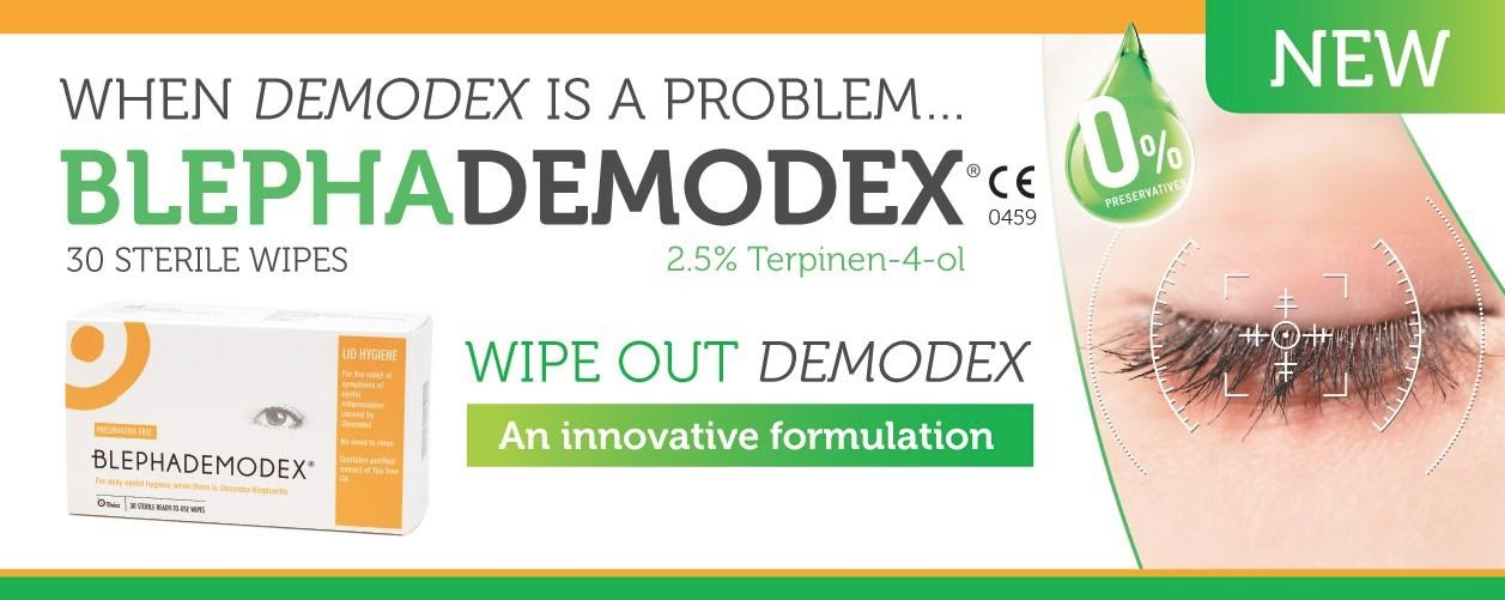
Image (22) Courtesy of Thea Pharmaceuticals
Eyedrops by Thea Pharmaceuticals
”Once Cleansed, you now need to give your eyes the additional lubrication and hydration for all day and all night comfort.
This can be achieved by regularly applying dry eye drops. These should be preservative free and, ideally, offer long-lasting protection.
Quote: Thea Pharmaceuticals – www.youreyehealth.co.uk
To keep formulations preservative-free, companies like Thea Pharmaceuticals have demonstrated their ingenuity by designing unique dispensing bottles that have an anti-bacterial filtering system.
A lot of thought has been dedicated to these bottles to make them easy to use, contamination-free and to allow a precise measure of drops to be instilled, avoiding product waste. As the eye drops are preservative-free, they can be used several times during the day.
The soft, ‘squeezy’ bottles permit the least dexterous customers to administer the drops themselves. As a result, customers that are elderly, or patients that may have arthritis, Parkinson’s or a frozen shoulder, can all independently use the drops, should a helper not be present. Apart from the first and last drop, the Thea bottles will dispense droplets even when held at a tilt.
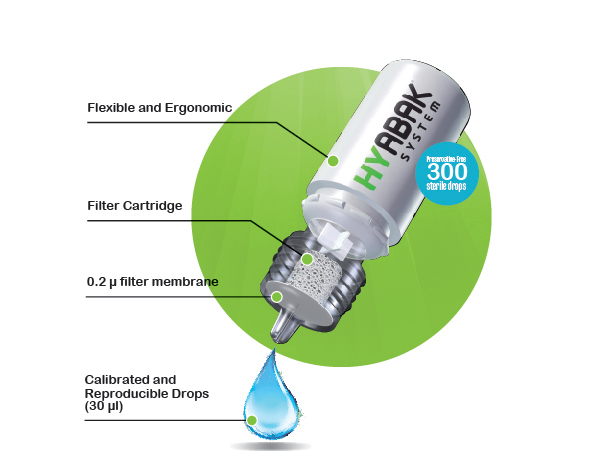
Image (23) ABAK System
Thealoz Duo: This premium dry-eye solution increases the tear film thickness and creates a protective layer due to its biochemical ingredients. Thealoz Duo contains a natural protein-stabilizer known as Trehalose. It is a bio-protectant used to preserve donor organs during transport15.
Trehalose is an essential source of energy protecting many organisms from extreme stresses such as dryness and freezing. Trehalose has another function to provide osmoprotection by balancing the level of water and salts in the tear film, ridding the sensation of ‘burning’ eyes which happens as a result of evaporation of the watery layer of the tear film. Additionally, sodium hyaluronate is applied to the solution, to deliver long-lasting hydration.

Image (24) Dried plant containing Trehalose, is ‘resurrected’ when water is added. Image courtesy of TruthinAging.com
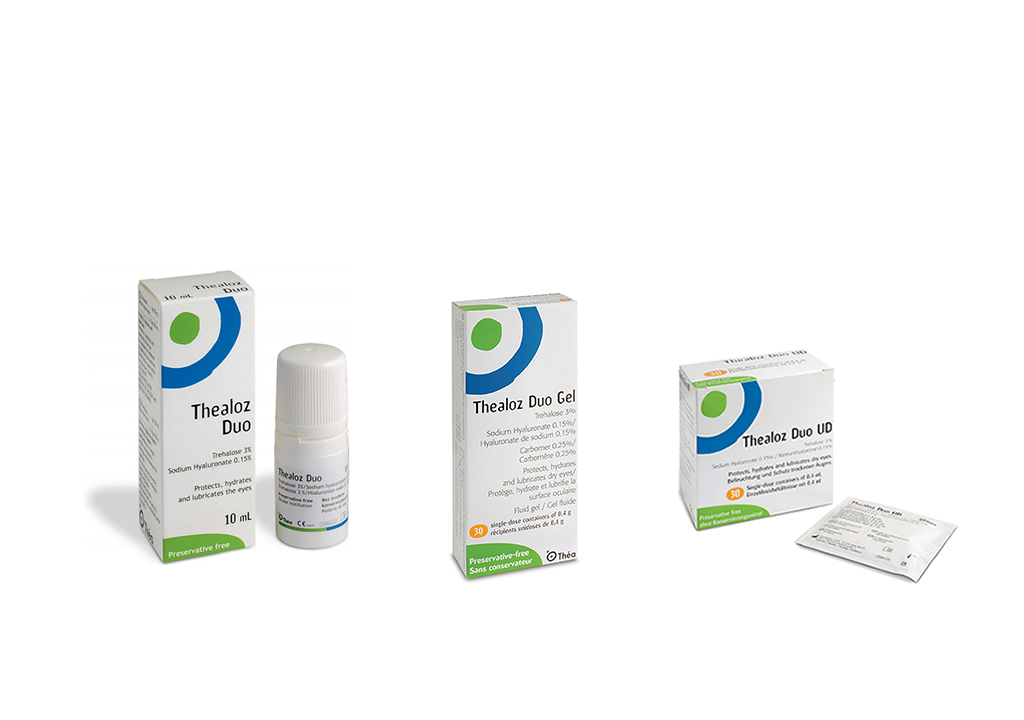
Image (25) Image Courtesy of PharmacyFirst.co.uk
The Thealoz Duo range is available in multiple variations catering for all customers including contact lens wearers. The 10ml bottle is suitable for 3 months use (approximately 300 drops per bottle). The individual minim dose packs are designed for the occasional user or traveller.
Thealoz Duo GEL is suitable for patients with moderate to severe dry eye. It can be applied at any time, but due to its viscose nature, avoid driving immediately after application. It is highly recommended for night time use, adding a layer of richness to the already hydrating and protective formula. Contact lens wearers should remove their lenses before instilling these drops, and wait roughly 30 minutes before putting their CLs back in.
Hyabak: For the occasional dry eye sufferer, Hyabak is a cost-friendly product, which comes in at a lower price point than the premium Thealoz range. For customers wishing to move away from cheaper, preservative products on the market, Hyabak is an excellent recommendation. It is suitable for regular use, including contact lens wear.
The key difference between Thealoz Duo and Hyabak is the moisturising content. Whilst the former product refreshes the tears to a deeper level using trehalose and sodium hyaluronate, the Hyabak formula does not contain trehalose, but is enriched with the same hyaluronic acid essence, which targets the surface layer of the tears. Both products are hypotonic, balancing the water and salt concentrations in the tear film.
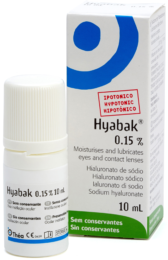
Image (26) Courtesy of Thea Pharmaceuticals
Nutrof Total Supplements: Nutrition is the most fundamental recommendation for building eye health. Whilst people are living longer, they are not necessarily living ‘better’. By adapting lifestyle changes and being mindful of nutrition, it is possible to “live well and see well”16. A healthy diet should consist of a colourful array of fruits, vegetables, whole grains, nuts and Omega-oils, just to name a few17.
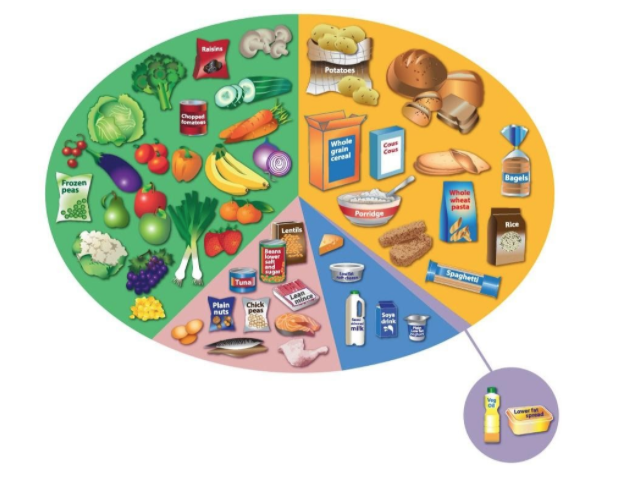
Image (27) Courtesy of NHS
Since people are living longer, the incidence of ‘age-related eye diseases’ is also on the rise. These conditions include age-related macular degeneration (AMD), cataracts and glaucoma. Whilst a favourable diet is a positive attribute to sustaining a healthy body, some nutrients fall short, as we age, and not all of the required levels of nutrition can be obtained from our daily dietary intake. Nutrof Total is a preservative-free, daily supplement that delivers the recommended dosage of nutrition, in an easy-to-swallow capsule.
The formula has been specifically created to target eye health. The pharmaceutical-grade ingredients are of a high-dose concentration. If a patient is taking prescribed medication, check with the GP or pharmacist first, before taking the supplement. The capsules aim to target all of the vital structures of the eye including the tear film. The Omega-rich content of the supplement reduces dry eye symptoms by strengthening the lubrication factor in the tear film.
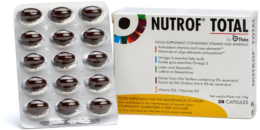
Image (28) Courtesy of Thea Pharmaceuticals
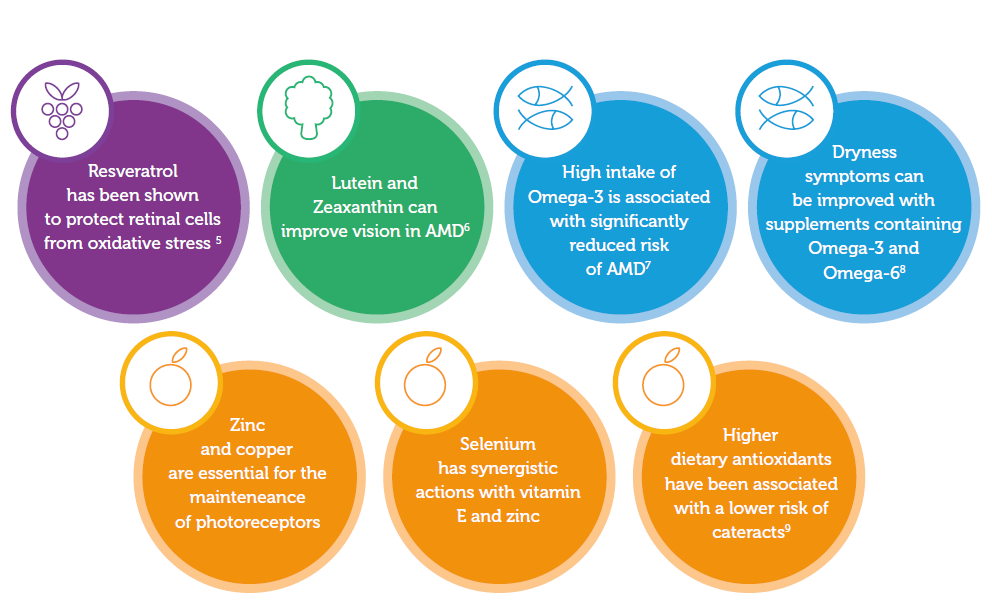
Image (29) Courtesy of Your Eye Health
Author’s final thought
Dry eye diseases are not a new-age problem, but they are most certainly exasperated by modern age living (VDU screens, multiple digital devices, not switching off from work, fast-food). To alleviate dry eye issues, it is clear that one has to adopt a new management technique that includes elements of lifestyle changes, better nutrition and eyelid cleansing programmes that encourage the production of a healthy tear film. Further aided by advanced lubricating and repairing eyedrops, patients should not have to tolerate dry eye issues anymore.
Being trained by Thea Pharmaceuticals, and by using their entire product range since 2013, I can confidently recommend Thea for one of the most comprehensive management systems, to repair and sustain healthy eyes.
* poor vision in dimly lit area’s and night time
** only ‘prescription’ products contain preservatives
-
Health.ny.gov – smoking can lead to vision loss or blindness
-
Feelgoodcontacts.com – how dehydration impacts your eyes
-
Coopervision.com – what is the effect of Alcohol on the Eye?
-
Healthline.com – what are Omega-3 fatty acids?
-
Mayoclinic.org – fish oil supplements and dry eyes
-
Allaboutvision.com – eye benefits of vitamin A and beta-carotene
-
Medicalnewstoday.com – which vitamins are good for dry eyes?
-
Youreyesite.com – blinking exercises you can try for greater comfort
-
Allaboutvision.com – punctal plugs for dry eyes
-
Medicalnewstoday.com – punctal plugs: side effects and relief
-
Myclevelandclinic.org – entropion management
-
NHS.UK – conditions/ectropion
-
Mayoclinic.org – Ectropion
-
Eyebagcompany.com
-
Onlinelibrary.wiley.com/doi/full/10.1111/ajt.14320
-
Quote Mr Jason Halsey, Area sales manager, Thea Pharmaceuticals
-
GOV.UK/government/publications/the-eatwell-guide
Posts by Oodo may include affiliate links. This means that we make a small commission from referrals and purchases at no extra cost to you. Thank you for your kind support.



